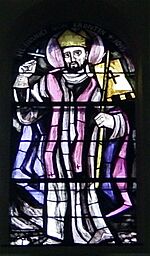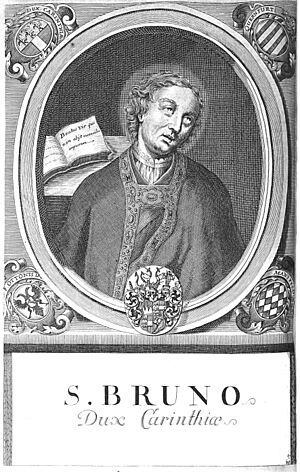Bruno (bishop of Würzburg) facts for kids
Quick facts for kids Saint Bruno of Würzburg |
|
|---|---|

Saint Bruno of Würzburg in a stained glass window from the parish church of Liesing by Martin Häusle
|
|
| Born | c. 1005 |
| Died | 27 May 1045 |
| Venerated in | Roman Catholicism Eastern Orthodox Church, see http://www.orthodoxengland.org.uk/saintsb.htm |
| Feast | 27 May |
Bruno of Würzburg (born around 1005, died May 27, 1045) was an important figure in the Holy Roman Empire. He was also known as Bruno of Carinthia. He served as a top official, called the imperial chancellor, for Italy from 1027 to 1034. He worked for Emperor Conrad II, who was his relative. Later, from 1034 until he died, he became the prince-bishop of Würzburg.
Contents
Early Life and Imperial Role
Bruno was the son of Conrad I, Duke of Carinthia, and Matilda of Swabia. This made him a cousin of Emperor Conrad II, who belonged to the Salian family. Bruno played a part in important royal marriages. He helped arrange the marriage for Emperor Conrad's son, Henry III, to Agnes of Poitou.
Building Projects in Würzburg
Bruno was also very active in building and rebuilding churches. He helped start the construction of the Würzburg Cathedral. In 1042, he officially opened the Abbey of St. Burchard. This abbey had been rebuilt by Abbot Willemund.
Journey with Emperor Henry III
Bruno also traveled with Emperor Henry III on a military campaign. This was Henry's second trip to Hungary. During this journey, Bruno sadly died in an accident. This happened at a place called Persenbeug, near the Danube River in what is now Austria.
Bruno's Death
Emperor Henry III and his group had stopped at the home of Countess Richlinde of Ebersberg. The countess was busy dividing up the property of her husband, who had recently passed away. During a large dinner party, a main support pillar in the dining hall broke. This caused the whole floor to fall down.
The king was only slightly hurt. However, Countess Richlinde, Bishop Bruno, and Abbot Altmann were badly injured. They did not survive for more than a few days after the accident. Bruno's body was brought back to his home city of Würzburg.
After Bruno's death, his nephew, Adalbero of Würzburg, took his place as bishop.
Burial and Legacy
Many large cathedrals were built during Bruno's time. Starting in 1040, Bruno began building the Würzburg Cathedral. The underground part of the cathedral, called the crypt, was officially opened on June 16, 1045. This ceremony was also combined with Bruno's burial.
Bruno was not officially made a saint by the Roman Catholic Church. However, he is still honored and respected as a saint by many people. His special day, or feast day, is May 17.
Bruno also wrote a well-known book. It was a commentary on the Psalms, which are religious songs from the Bible. He also added an analysis of ten other Biblical hymns. These analyses included parts from the writings of early Christian leaders, known as the Church Fathers.


